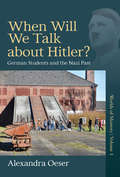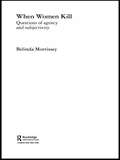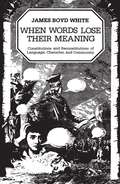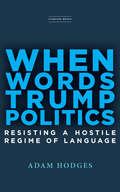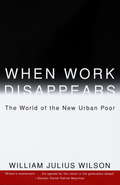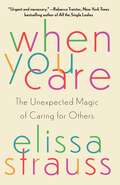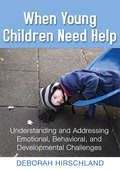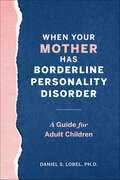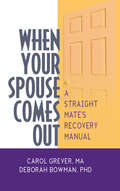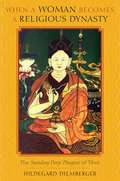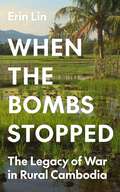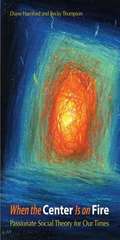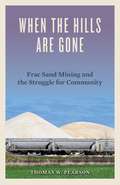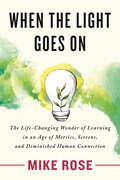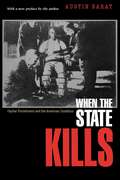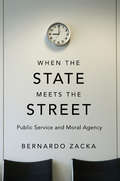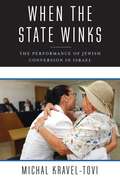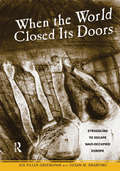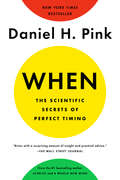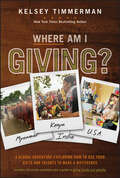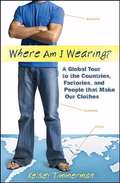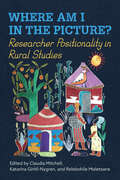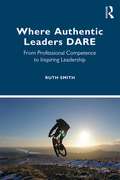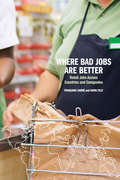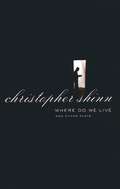- Table View
- List View
When Will We Talk About Hitler?: German Students and the Nazi Past (Worlds of Memory #1)
by Alexandra OeserFor more than half a century, discourses on the Nazi past have powerfully shaped German social and cultural policy. Specifically, an institutional determination not to forget has expressed a “duty of remembrance” through commemorative activities and educational curricula. But as the horrors of the Third Reich retreat ever further from living memory, what do new generations of Germans actually think about this past? Combining observation, interviews, and archival research, this book provides a rich survey of the perspectives and experiences of German adolescents from diverse backgrounds, revealing the extent to which social, economic, and cultural factors have conditioned how they view representations of Germany’s complex history.
When Women Kill: Questions of Agency and Subjectivity (Transformations)
by Belinda MorrisseyWhy are we so reluctant to believe that women can mean to kill? Based on case-studies from the US, UK and Australia, this book looks at the ways in which female killers are constructed in the media, in law and in feminist discourse almost invariably as victims rather than actors in the crimes they commit. Morrissey argues that by denying the possibility of female agency in crimes of torture, rape and murder, feminist theorists are, with the best of intentions, actually denying women the full freedom to be human. Case studies cover among others the battered wife, Pamela Sainsbury, who garrotted her husband as he slept, the serial killer, Aileen Wournos, who killed seven middle-aged men in Florida between 1989 and 1990, Tracey Wiggington, the so-called "lesbian vampire killer", and Karla Homolka who helped her husband kill two teenage girls in St. Catherines Ontario in 1993.
When Words Lose Their Meaning: Constitutions and Reconstitutions of Language, Character, and Community
by James Boyd WhiteThrough fresh readings of texts ranging from Homer's Iliad, Swift's Tale of a Tub, and Austen's Emma through the United States Constitution and McCulloch v. Maryland, James Boyd White examines the relationship between an individual mind and its language and culture as well as the "textual community" established between writer and audience. These striking textual analyses develop a rhetoric—a "way of reading" that can be brought to any text but that, in broader terms, becomes a way of learning that can shape the reader's life. "In this ambitious and demanding work of literary criticism, James Boyd White seeks to communicate 'a sense of reading in a new and different way.' . . . [White's] marriage of lawyerly acumen and classically trained literary sensibility—equally evident in his earlier work, The Legal Imagination—gives the best parts of When Words Lose Their Meaning a gravity and moral earnestness rare in the pages of contemporary literary criticism."—Roger Kimball, American Scholar "James Boyd White makes a state-of-the-art attempt to enrich legal theory with the insights of modern literary theory. Of its kind, it is a singular and standout achievement. . . . [White's] selections span the whole range of legal, literary, and political offerings, and his writing evidences a sustained and intimate experience with these texts. Writing with natural elegance, White manages to be insightful and inciteful. Throughout, his timely book is energized by an urgent love of literature and law and their liberating potential. His passion and sincerity are palpable."—Allan C. Hutchinson, Yale Law Journal "Undeniably a unique and significant work. . . . When Words Lose Their Meaning is a rewarding book by a distinguished legal scholar. It is a showcase for the most interesting sort of inter-disciplinary work: the kind that brings together from traditionally separate fields not so much information as ideas and approaches."—R. B. Kershner, Jr., Georgia Review
When Words Trump Politics: Resisting a Hostile Regime of Language
by Adam HodgesTrumpism has not only ushered in a new political regime, but also a new regime of language—one that cries out for intelligent and informed analysis. When Words Trump Politics takes insights from linguistic anthropology and related fields to decode, understand, and ultimately provide non-expert readers with easily digestible tools to resist the politics of division and hate. Adam Hodges's short essays address Trump's Twitter insults, racism and white nationalism, "truthiness" and "alternative facts," #FakeNews and conspiracy theories, Supreme Court politics and #MeToo, Islamophobia, political theater, and many other timely and controversial discussions. Hodges breaks down the specific linguistic techniques and processes that make Trump's rhetoric successful in our contemporary political landscape. He identifies the language ideologies, word choices, and recurring metaphors that underlie Trumpian rhetoric. Trumpian discourse works in tandem with media discourse—Hodges shows how Trump often induces journalists and social media agents to recycle and strengthen his spectacular and misleading claims. Those who study democracy have long emphasized the need for an informed electorate. But being informed on political issues also demands a keen understanding of the way language is used to convey, discuss, debate, and contest those issues. When Words Trump Politics analyzes the political rhetoric of today. The actionable insights in this book give journalists, politicians, and all Americans the successful tools they need to respond to the politics of hate. When Words Trump Politics is an essential resource for political resistance, for anyone who cares about freeing democracy from the spell of demagoguery.
When Work Disappears
by William Julius WilsonWilson, one of our foremost authorities on race and poverty, challenges decades of liberal and conservative pieties to look squarely at the devastating effects that joblessness has had on our urban ghettos. Marshaling a vast array of data and the personal stories of hundreds of men and women, Wilson persuasively argues that problems endemic to America's inner cities--from fatherless households to drugs and violent crime--stem directly from the disappearance of blue-collar jobs in the wake of a globalized economy. Wilson's achievement is to portray this crisis as one that affects all Americans, and to propose solutions whose benefits would be felt across our society. At a time when welfare is ending and our country's racial dialectic is more strained than ever, When Work Disappears is a sane, courageous, and desperately important work."Wilson is the keenest liberal analyst of the most perplexing of all American problems...[This book is] more ambitious and more accessible than anything he has done before."--The New YorkerFrom the Trade Paperback edition.
When You Care: The Unexpected Magic of Caring for Others
by Elissa StraussIn this &“brilliantly argued and timely book&” (Brigid Schulte, New York Times bestselling author), journalist Elissa Strauss explores the powerful role caring for others plays in our individual and communal lives, weaving together research about care and stories from parents and caregivers with a feminist bent.Behind our current caregiving crisis, in which a broken system has left parents and caregivers exhausted, sits a fierce addiction to independence. But what would happen if we started to appreciate dependency, and the deep meaning of one person caring for another? If we start to care about care? Drawing on research into parenting and caregiving, as well as her own experiences as a mother, journalist Elissa Strauss delves into the history and power of care in our lives and communities. With a curiosity and desire to more fully understand one of humanity&’s most profound and essential relationships, she interrogates our societal obsession with going it alone, and poses a challenge to let ourselves be transformed by the act of caregiving. When You Care weaves historical anecdotes and science with conversations with parents and caregivers to the young, old, disabled, ill, and more, revealing a rich array of insights about how care shapes us on the inside and the outside, for the better. Care is a long-ignored force in our collective and political lives, as well as a deeply philosophical, spiritual, and psychologically potent experience. Moreso, an embrace of care by both women and men will lead to a more gender equitable future and help us reimagine what it means to be productive and live a meaningful life. The result is an eye-opening exploration into the power of being depended on—and a stirring call to action to finally acknowledge the breadth, depth, and beauty of all that caregivers do.
When Young Children Need Help
by Deborah HirschlandLearn how to reach children who need special help.Almost anyone who works with 3- to 6-year-olds knows what it feels like to spend time with youngsters who are particularly puzzling or hard to help. When Young Children Need Help examines how early childhood educators can make sense of what is going on for such children and then use that understanding to help promote growth and mastery. Written for child care center staff, family child care providers, preschool teachers, and pre-service teachers, this book can be useful to any adult who wants to learn more about reaching the most troubling children in his or her care.When Young Children Need Help provides a framework for understanding a range of emotional, behavioral, and developmental challenges. It explores a process through which early childhood teachers and providers can translate their growing understanding of a child's difficulties into sensible goals for intervention. The author lays out practical strategies that help kids connect and communicate with ease, focus their attention, manage their bodies and their feelings, engage in constructive problem-solving, and experience themselves as successful friends and learners. The book suggests approaches for collaborating with parents and other caregivers and emphasizes that even when a child needs outside services and supports, what goes on in school or care remains central to making progress.Ranging from the classroom to the playground and back again, When Young Children Need Help offers its perspectives and strategies through highly engaging stories that bring challenging kids alive in all their quirky uniqueness.
When Your Mother Has Borderline Personality Disorder: A Guide for Adult Children
by Daniel S. LobelCaring for yourself and your relationship with your mom who has BPD.Growing up with a mom who has Borderline Personality Disorder (BPD) is difficult—but it's still possible to have a functioning adult relationship with her. When Your Mother Has Borderline Personality Disorder provides you with crucial information for understanding the patterns behind her Borderline Personality Disorder, as well as the tools you need to start your own recovery process.Find ways to reconcile your complicated thoughts and feelings with straightforward and easy-to-use techniques. You'll also discover a number of sample dialogues that give you blueprints for safe and secure interactions in a variety of situations.When Your Mother Has Borderline Personality Disorder includes:You, your mother, and Borderline Personality Disorder—Learn why your mother behaves the way she does and how to maintain a relationship with her—without getting hurt.The help you need—Start healing with essential self-care strategies that will help you rebuild your self-esteem, cope with anxiety, protect your family, and more.Research-based tools—Get proven advice based on the most up-to-date approaches for managing a relationship with someone who has Borderline Personality Disorder.Get the help you need moving forward with the compassionate guidance of When Your Mother Has Borderline Personality Disorder.
When Your Spouse Comes Out: A Straight Mate's Recovery Manual
by Carol Grever Deborah BowmanEffective therapeutic self-help techniques for a straight mate’s recovery One of the most traumatic events that can happen in a marriage is discovering your mate is gay. When Your Spouse Comes Out: A Straight Mate’s Recovery Manual is a comprehensive exploration of the trauma that provides practical steps that successful individuals have taken to keep this event from ruining their future. This guide offers solid therapeutic techniques for self-help and presents poignant true stories that illustrate that the damage is not irreparable. The book examines the various reactions to the coming-out event, the personal challenges and obstacles often experienced, and shares lessons learned and some of the secrets of transformation. When this crisis hits home, isolation, depression, anger, grief, and self-recrimination take root. When Your Spouse Comes Out: A Straight Mate’s Recovery Manual presents role models, analysis, practices, and activities promoting long-term emotional recovery for heterosexual men and women whose intimate partners are gay. The text includes integrated exercises helpful for class work and student discussion and case studies of people who recount their stories and explain their recovery. Topics in When Your Spouse Comes Out: A Straight Mate’s Recovery Manual include: different straight spouse responses to the coming out event diverse ways gay mates approach coming out typical stages of coping by straight spouses health risks how to tell the children helping children with the resulting challenges paths toward healing recreating family and more When Your Spouse Comes Out: A Straight Mate’s Recovery Manual offers a self-directed path to recovery which can be used individually or in the context of a support group. This guide is invaluable for straight spouses working alone or in groups, therapists, counselors, group facilitators, librarians, families of gays/lesbians, and their mates.
When a Woman Becomes a Religious Dynasty: The Samding Dorje Phagmo of Tibet
by Hildegard DiembergerIn the fifteenth century, the princess Chokyi Dronma was told by the leading spiritual masters of her time that she was the embodiment of the ancient Indian tantric deity Vajravarahi, known in Tibetan as Dorje Phagmo, the Thunderbolt Female Pig. After suffering a great personal tragedy, Chokyi Dronma renounced her royal status to become a nun, and, in turn, the tantric consort of three outstanding religious masters of her era. After her death, Chokyi Dronma's masters and disciples recognized a young girl as her reincarnation, the first in a long, powerful, and influential female lineage. Today, the twelfth Samding Dorje Phagmo leads the Samding monastery and is a high government cadre in the Tibet Autonomous Region.Hildegard Diemberger builds her book around the translation of the first biography of Chokyi Dronma recorded by her disciples in the wake of her death. The account reveals an extraordinary phenomenon: although it had been believed that women in Tibet were not allowed to obtain full ordination equivalent to monks, Chokyi Dronma not only persuaded one of the highest spiritual teachers of her era to give her full ordination but also established orders for other women practitioners and became so revered that she was officially recognized as one of two principal spiritual heirs to her main master.Diemberger offers a number of theoretical arguments about the importance of reincarnation in Tibetan society and religion, the role of biographies in establishing a lineage, the necessity for religious teachers to navigate complex networks of political and financial patronage, the cultural and social innovation linked to the revival of ancient Buddhist civilizations, and the role of women in Buddhism. Four introductory, stage-setting chapters precede the biography, and four concluding chapters discuss the establishment of the reincarnation lineage and the role of the current incarnation under the peculiarly contradictory communist system.
When the Bombs Stopped: The Legacy of War in Rural Cambodia (Princeton Studies in International History and Politics #206)
by Erin LinHow undetonated bombs from a war that ended more than fifty years ago still affect Cambodian farmers and their land Over the course of the Vietnam War, the United States dropped 500,000 tons of bombs over Cambodia—more than the combined weight of every man, woman, and child in the country. What began as a secret CIA infiltration of Laos eventually expanded into Cambodia and escalated into a nine-year war over the Ho Chi Minh trail fought primarily with bombs. Fifty years after the last sortie, residents of rural Cambodia are still coping with the unexploded ordnance that covers their land. In When the Bombs Stopped, Erin Lin investigates the consequences of the US bombing campaign across postconflict Cambodia.Drawing on interviews, original econometric analysis, and extensive fieldwork, Lin upends the usual scholarly perspective on the war and its aftermath, presenting the viewpoint of those who suffered the bombing rather than those who dropped the bombs. She shows that Cambodian farmers stay at a subsistence level because much of their land is too dangerous to cultivate—and yet, paradoxically, the same bombs that endanger and impoverish farming communities also protect them, deterring predatory elites from grabbing and commodifying their land. Lin argues that the half-century legacy of American bombs has sedimented the war into the layers of contemporary Cambodian society. Policies aimed at developing or modernizing Cambodia, whether economic liberalization or authoritarian consolidation, must be realized in an environment haunted by the violence of the past. As the stories Lin captures show, the bombing served as a critical juncture in these farming villages, marking the place in time where development stopped.
When the Center is on Fire
by Becky Thompson Diane HarrifordIn this lively and provocative book, two feminist public sociologists turn to classical social thinkers--W. E. B. Du Bois, Max Weber, Karl Marx, and Émile Durkheim--to understand a series of twenty-first century social traumas, including the massacre at Columbine High School, the 9/11 attacks, the torture at Abu Ghraib prison, and Hurricane Katrina. Each event was overwhelming in its own right, while the relentless pace at which they occurred made it nearly impossible to absorb and interpret them in any but the most superficial ways. Yet, each uncovered social problems that cry out for our understanding and remediation. In When the Center Is on Fire, Becky Thompson and Diane Harriford assert that classical social theorists grappled with the human condition in ways that remain profoundly relevant. They show, for example, that the loss of "double consciousness" that Du Bois identified in African Americans enabled political elites to turn a blind eye to the poverty and vulnerability of many of New Orleans's citizens. The authors' compelling, sometimes irreverent, often searing interpretations make this book essential reading.
When the Hills Are Gone: Frac Sand Mining and the Struggle for Community
by Thomas W. PearsonFracking is one of the most controversial methods of fossil fuel extraction in the United States, but a great deal about it remains out of the public eye. In Wisconsin it has ignited an unprecedented explosion in the state&’s sand mining operations, an essential ingredient in hydraulic fracturing that has shaken local communities to the core.In When the Hills Are Gone, Thomas W. Pearson reveals the jolting impact of sand mining on Wisconsin&’s environment and politics. A source of extraordinary wealth for a lucky few, and the cause of despoiled land for many others, sand mining has raised alarm over air quality, water purity, noise, blasting, depressed tourism, and damage to the local way of life. It has also spurred a backlash in a grassroots effort that has grown into a mature political movement battling a powerful mining industry.When the Hills Are Gone tells the story of Wisconsin&’s sand mining wars. Providing on-the-ground accounts from both the mining industry and the concerned citizens who fought back, Pearson blends social theory, ethnography, stirring journalism, and his own passionate point of view to offer an essential chapter of Wisconsin&’s history and an important episode in the national environmental movement. Digging deep into the struggles over place, community, and local democracy that are occurring across the United States, When the Hills Are Gone gives vital insight into America&’s environmental battles along the unexpected frontlines of energy development.
When the Light Goes On: The Life-Changing Wonder of Learning in an Age of Metrics, Screens, and Diminish ed Human Connection
by Mike RoseThe final work from one of the most beloved voices in American education explores stories and lessons of transformative experiences in educationFor more than a generation, American education has been structured as though it was built of and for concepts, not people. This has transformed education into a vast assessment, scoring, and ranking enterprise; a sales platform for high-tech entrepreneurs; and a fiercely competitive arena of advantage and status that grinds the poor and propels the middle class into debt.In When the Light Goes On, educator Mike Rose features the stories of people of all ages and backgrounds to illuminate how education has added meaning to their lives. The inspiring stories include:-A supermarket checker whose job wore away his soul takes a remedial math class that starts him on a path toarchitecture school-A young man badly injured in a motorcycle accident finds both rehabilitation and a career in a welding program.-A transgender youth&’s odyssey to self-definition extends though courses in social sciences and campus advocacy groups.-A Native American athlete finds graduate study as a way to use her celebrity to articulate the needs of her people. When the Light Goes On helps us dig through the discord and fragmentation of school politics and policy to reclaim the mind and heart of education. Through various students&’ stories and his own, Rose provides an urgent reminder of the core purpose of education: to learn about ourselves and the world around us, to spark new interests, and to experience with guidance both the fulfillment and the uncertainty of exploring our limits—all in the service of creating a meaningful life.
When the State Kills: Capital Punishment and the American Condition
by Austin SaratIs capital punishment just? Does it deter people from murder? What is the risk that we will execute innocent people? These are the usual questions at the heart of the increasingly heated debate about capital punishment in America. In this bold and impassioned book, Austin Sarat seeks to change the terms of that debate. Capital punishment must be stopped, Sarat argues, because it undermines our democratic society. Sarat unflinchingly exposes us to the realities of state killing. He examines its foundations in ideas about revenge and retribution. He takes us inside the courtroom of a capital trial, interviews jurors and lawyers who make decisions about life and death, and assesses the arguments swirling around Timothy McVeigh and his trial for the bombing in Oklahoma City. Capital punishment, Sarat shows, ultimately leaves Americans more divided, hostile, indifferent to life's complexities, and much further from solving the nation's ills. In short, it leaves us with an impoverished democracy. The book's powerful and sobering conclusions point to a new abolitionist politics, in which capital punishment should be banned not only on ethical grounds but also for what it does to Americans and what we cherish.
When the State Meets the Street: Public Service and Moral Agency
by Bernardo ZackaBernardo Zacka probes the complex moral lives of street-level bureaucrats—the frontline social and welfare workers, police officers, and educators who represent government’s human face to ordinary citizens. Too often dismissed as soulless operators, these workers wield significant discretion and make decisions that profoundly affect people’s lives.
When the State Winks: The Performance of Jewish Conversion in Israel (Religion, Culture, and Public Life #5)
by Michal Kravel-ToviReligious conversion is often associated with ideals of religious sincerity. But in a society in which religious belonging is entangled with ethnonational citizenship and confers political privilege, a convert might well have multilayered motives. Over the last two decades, mass non-Jewish immigration to Israel, especially from the former Soviet Union, has sparked heated debates over the Jewish state’s conversion policy and intensified suspicion of converts’ sincerity. When the State Winks carefully traces the performance of state-endorsed Orthodox conversion to highlight the collaborative labor that goes into the making of the Israeli state and its Jewish citizens.In a rich ethnographic narrative based on fieldwork in conversion schools, rabbinic courts, and ritual bathhouses, Michal Kravel-Tovi follows conversion candidates—mostly secular young women from a former Soviet background—and state conversion agents, mostly religious Zionists caught between the contradictory demands of their nationalist and religious commitments. She complicates the popular perception that conversion is a “wink-wink” relationship in which both sides agree to treat the converts’ pretenses of observance as real. Instead, she demonstrates how their interdependent performances blur any clear boundary between sincere and empty conversions. Alongside detailed ethnography, When the State Winks develops new ways to think about the complex connection between religious conversion and the nation-state. Kravel-Tovi emphasizes how state power and morality is managed through “winking”—the subtle exchanges and performances that animate everyday institutional encounters between state and citizen. In a country marked by tension between official religiosity and a predominantly secular Jewish population, winking permits the state to save its Jewish face.
When the World Closed Its Doors: Struggling to Escape Nazi-occupied Europe
by Ida Piller-Greenspan Susan M. Branting"[A] memoir of one couple's escape from the Nazis ...[full of] ingenuity and determination." Michael R. Marrus, Professor of Holocaust Studies, University of Toronto At the beginning of World War II, the US and other countries erected a "paper wall"-- a bureaucratic maze that prevented all but a small number of Jewish refugees from emigrating from Nazi-Occupied Europe.When the World Closed Its Doors tells the true story of a young couple who, like many European Jews, were caught between the Nazis and the "paper wall". Ida Piller-Greenspan was married in Belgium on May 9, 1940. That night the Nazis invaded Belgium. She and her new husband survived the next four months hitchhiking through occupied territory, hiding in barns and tunnels, dodging bombs near Dunkirk, crossing the Pyrenees on foot, and enduring weeks with little food and no money. Ultimately they arrived in Portugal, certain they would find sanctuary somewhere in the world beyond Europe's borders. But their trials were not over. It took nine anxious months for them to find a country that would let them in -- months spent watching in horror as most refugees were forced back to uncertain lives in their home countries. Forty years later, Ida, an accomplished artist, created a pictorial diary of their journey. Her prints -- lyrical, haunting, and compelling -- are accompanied by a page-turning narrative that bears witness to this treacherous and largely forgotten chapter of World War II history.
When: The Scientific Secrets of Perfect Timing
by Daniel H. Pink<P>Daniel H. Pink, the #1 bestselling author of Drive and To Sell Is Human, unlocks the scientific secrets to good timing to help you flourish at work, at school, and at home. <P>Everyone knows that timing is everything. But we don't know much about timing itself. Our lives are a never-ending stream of "when" decisions: when to start a business, schedule a class, get serious about a person. Yet we make those decisions based on intuition and guesswork. <P>Timing, it's often assumed, is an art. In When: The Scientific Secrets of Perfect Timing, Pink shows that timing is really a science. <P>Drawing on a rich trove of research from psychology, biology, and economics, Pink reveals how best to live, work, and succeed. How can we use the hidden patterns of the day to build the ideal schedule? Why do certain breaks dramatically improve student test scores? How can we turn a stumbling beginning into a fresh start? Why should we avoid going to the hospital in the afternoon? Why is singing in time with other people as good for you as exercise? And what is the ideal time to quit a job, switch careers, or get married? <P>In When, Pink distills cutting-edge research and data on timing and synthesizes them into a fascinating, readable narrative packed with irresistible stories and practical takeaways that give readers compelling insights into how we can live richer, more engaged lives. <P><b>A New York Times Bestseller</b>
Where Am I Giving: A Global Adventure Exploring How To Use Your Gifts And Talents To Make A Difference (Where am I?)
by Kelsey TimmermanYour gifts connect you to a world of giving Americans are generous with their pocketbooks, but trying to make a difference and actually making a difference are two different things. Where Am I Giving? by New York Times bestselling author Kelsey Timmerman takes you on a journey to meet people who will inspire you to live a purpose-filled, generous life and make the greatest impact you can through your career, time, consumer dollars, and donations. Starting in his hometown of Muncie, Indiana, and then traveling all over the world (Myanmar, Kenya, India, Nepal, and more), Kelsey explores not only different ways of giving—as a worker, consumer, volunteer, giver, local and global citizen—but also the benefits and effectiveness of these methods. He spends time with monks, students, a refugee, a Marine, a former Hollywood executive, Peace Corps Volunteers, and seasoned aid workers to explore how they give, as well as with the people on the receiving end of their giving. Along the way he struggles to be a more informed giver as he becomes a "voluntourist,” starts his own local non-profit, and searches for a balance between rationality and passion in how he gives. This book will help you: Reveal the amazing opportunities you have to make an impact using your own gifts—and it doesn't have to be money Understand the sociology, philosophy, anthropology, and neuroscience of giving See how giving can make you more connected and happier Examine types of giving, including microlending, volunteering, donating, ethical consumption, mission trips, voluntourism, child sponsorship, etc. Dive into a nuanced view of effectiveness of international aid and its intersection with development, politics, and culture Where Am I Giving? is a fast-paced narrative combining compelling stories collected over 15 years of travel to 90+ countries, mixed with practical advice on how to make giving a part of our everyday lives.
Where Am I Wearing?: A Global Tour to the Countries, Factories, and People That Make Our Clothes
by Kelsey TimmermanGlobalization makes it difficult to know where the things you buy come from. Journalist and travel writer Kelsey Timmerman wanted to know where his clothes came from and who made them, so he traveled from Honduras to Bangladesh to Cambodia to China and back. Along the way, he met the people who made his favorite clothes and learned as much about them as he did about globalization itself. Enlightening and controversial at once, this book puts a human face on globalization.
Where Am I in the Picture?: Researcher Positionality in Rural Studies
by Claudia Mitchell Relebohile Moletsane Katarina Giritli-NygrenPositionality and researcher reflexivity – how to account for one’s subject position – remain as challenges for new researchers. But they also remain as challenges for experienced researchers, who are often involved in multiple research projects simultaneously. Where Am I in the Picture? sheds light on the idea of researcher positionality through visual methodologies, particularly in the context of studying rurality in Canada, Sweden, and South Africa. The book is intended for new and experienced researchers seeking to decolonize their own perspectives in research in the social sciences and humanities. It incorporates photographs, drawings, and memory work to highlight the social constructedness of what counts as rural. Drawing together compelling narratives from researchers about their positionality in studying rurality, the book highlights a need for greater attention to “where we are in the picture” more broadly. It suggests that when it comes to the rural, researchers need to rethink the interplay of dominant images, insider and outsider perspectives, and what this interplay means in relation to interpretation. Where Am I in the Picture? presents a new vision of how to take into consideration positionality in research.
Where Authentic Leaders DARE: From Professional Competence to Inspiring Leadership
by Ruth SmithThis book demonstrates, complete with practical exercises, how to be successful in both your work and your personal life by becoming a truly authentic leader and empathic influencer. Above all, it shows you how to do this with the positive intention of successful, connected communication and through honouring the other person’s perspective. The book is of particular value to managers and leaders who are very proficient in their areas of expertise and are looking for ways to improve team and personal performance further by developing their leadership and authentic influencing skills. The book provides you with: Clear reasons why authentic leadership and empathic influencing will help in work and personal relationships. How to develop these influencing skills and remain authentic. The evidence, including the relevant neuroscience, as to why this is important. A 'how to' guide. If you are looking for some practical exercises to help develop authentic leadership, then you can go straight here.
Where Bad Jobs Are Better: Retail Jobs Across Countries and Companies
by Francoise Carre Chris TillyRetail is now the largest employer in the United States. For the most part, retail jobs are “bad jobs” characterized by low wages, unpredictable work schedules, and few opportunities for advancement. However, labor experts Françoise Carré and Chris Tilly show that these conditions are not inevitable. In Where Bad Jobs Are Better, they investigate retail work across different industries and seven countries to demonstrate that better retail jobs are not just possible, but already exist. By carefully analyzing the factors that lead to more desirable retail jobs, Where Bad Jobs Are Better charts a path to improving job quality for all low-wage jobs. In surveying retail work across the United States, Carré and Tilly find that the majority of retail workers receive low pay and nearly half work part-time, which contributes to high turnover and low productivity. Jobs staffed predominantly by women, such as grocery store cashiers, pay even less than retail jobs in male-dominated fields, such as consumer electronics. Yet, when comparing these jobs to similar positions in Western Europe, Carré and Tilly find surprising differences. In France, though supermarket cashiers perform essentially the same work as cashiers in the United States, they receive higher pay, are mostly full-time, and experience lower turnover and higher productivity. And unlike the United States, where many retail employees are subject to unpredictable schedules, in Germany, retailers are required by law to provide their employees notice of work schedules six months in advance. The authors show that disparities in job quality are largely the result of differing social norms and national institutions. For instance, weak labor regulations and the decline of unions in the United States have enabled retailers to cut labor costs aggressively in ways that depress wages and discourage full-time work. On the other hand, higher minimum wages, greater government regulation of work schedules, and stronger collective bargaining through unions and works councils have improved the quality of retail jobs in Europe. As retail and service work continue to expand, American employers and policymakers will have to decide the extent to which these jobs will be good or bad. Where Bad Jobs Are Better shows how stronger rules and regulations can improve the lives of retail workers and boost the quality of low-wage jobs across the board.
Where Do We Live and Other Plays
by Christopher ShinnThis anthology marks the emergence of one of the finest and most innovative new artists writing for the theater today. "The secret of Shinn's success is in the way he exploits the dramatic gap between what is said and that which is left unsaid . . . writing like this is rare," said the London Independent. Where Do We Live, the title play, was written shortly after 9/11 and though never referenced, it still haunts this chronicle of the struggles of several aspiring and gifted young New Yorkers on the Lower East Side. Like all his work, it is a deeply affecting story of how we define our lives and our place in the world.The Coming World "Shinn certainly looks like a shining prospect for the future."--Daily TelegraphFour "Nothing is simple emotionally. The play keeps delivering small shocks and aches that end in a standoff, or maybe in that pause between despair, resignation and a twinge of hope. Haunting."--Margo Jefferson, The New York TimesOther People "Shinn writes with graceful compassion about people trapped inside their own skins unable to make sense of their lives."--The GuardianWhat Didn't Happen ". . . is about the distance between people, and the ways in which even friends, spouses and lovers are ultimately unknowable to one another . . . a playwright to cherish."--The New York TimesChristopher Shinn's plays have been produced at Playwrights Horizons, Manhattan Theatre Club, the Vineyard Theatre in New York and often at London's Royal Court Theatre. Where Do We Live received a 2003 Olivier Award nomination for most promising playwright. His next play, On the Mountain, premieres in New York City early in 2005.
